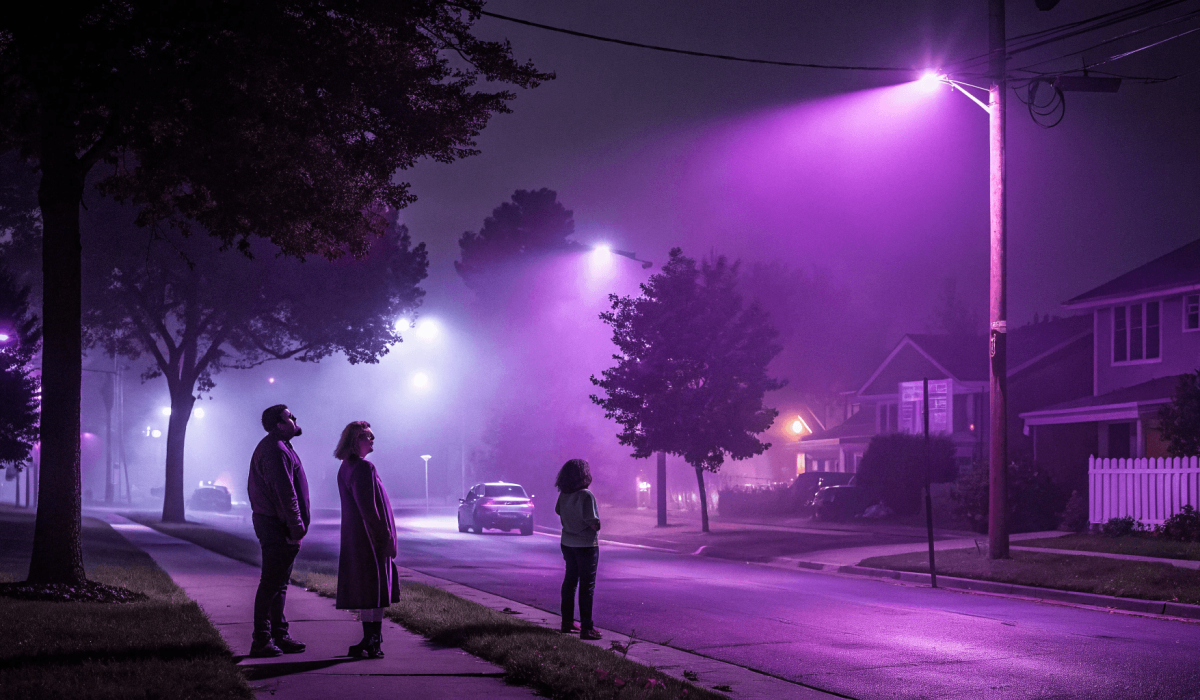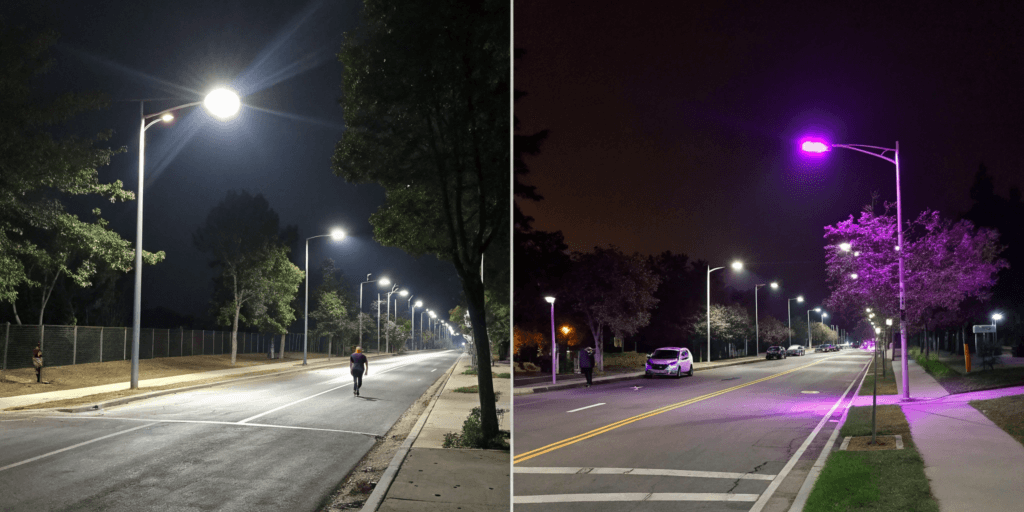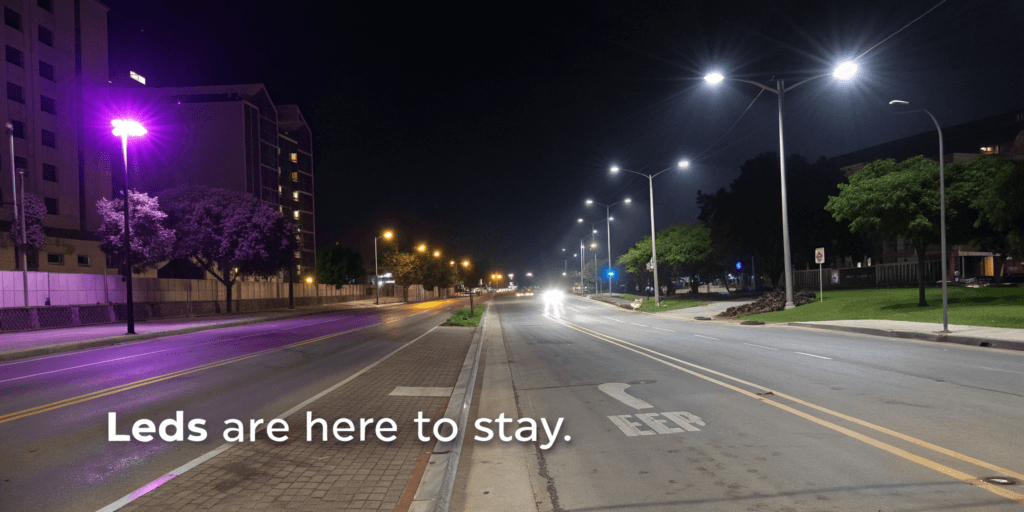Since 2021, an odd glow has been appearing across streets in the US, Canada, and Ireland—streetlights turning a deep purple, and no, it’s not on purpose.
Purple streetlights are the result of a manufacturing defect in LED fixtures, not a design choice—and they can impact visibility and public safety.
It looks like something out of a sci-fi film, but it’s real—and it’s spreading. From Florida to Toronto, people are looking up and asking, “Why is my streetlight glowing purple?” Here’s what’s actually going on.
Why Are Some Streetlights Suddenly Turning Purple?
They weren’t installed that way. And no, it’s not mood lighting for the city.
Streetlights in dozens of cities have unexpectedly changed color—from standard white to an eerie violet hue. This has happened since 2021 and is still ongoing.
The issue spans across North America and even parts of Europe. But despite the sudden color change, these lights weren’t designed to be purple. Most cities are just as surprised as residents.
So what’s behind this strange glitch?
How LED Streetlights Are Supposed to Work?
LEDs replaced sodium lamps because they save energy, last longer, and produce better-quality light.
LED streetlights are built using two main methods for creating “white” light:
- RGB Mixing: Combining red, green, and blue LEDs to form white
- Blue LED + Phosphor Coating: A blue diode coated with yellow phosphor, blending to appear white
The phosphor method is preferred in public lighting. It’s more stable, cost-effective, and produces a consistent light spectrum, ideal for roads and visibility.
But this method also reveals the flaw causing the purple lights.
What Causes Streetlights to Turn Purple?
It’s not a software glitch—it’s delamination of the phosphor coating.
When the yellow phosphor layer begins to peel, crack, or degrade, the blue base LED shines through more intensely—turning the light purple.
Several factors can lead to this failure:
- Heat Buildup: Poor thermal design causes the phosphor layer to degrade faster
- Vibrations from Traffic: Constant road-level shaking can loosen internal coatings
- Material or Manufacturing Defects: Subpar phosphor application or low-grade adhesives
- Gravity-Induced Stress: On large fixtures, the coating may sag or detach over time
The result? You get a light that looks like something from a nightclub instead of a safe urban intersection.
Why Purple Light Is a Problem: Vision and Safety Impacts?
At night, your eyes depend more on rods (for light detection) and less on cones (for color).
Purple light isn’t just unusual—it changes how our vision works in dark conditions:
- Reduces visual clarity: It becomes harder to distinguish objects, signs, or road markings
- Skews color contrast: Makes some colors appear faded or distorted
- Alters brightness perception: Purple light can look dimmer, leading to misjudgment of distance
- Increases eye fatigue: Especially for older drivers or those with vision issues
Peripheral vision might improve slightly under blue-toned light, but that comes at the cost of central sharpness and detail. This makes the road less predictable, especially at crosswalks or busy junctions.
Is It Dangerous?
Experts say it’s not dangerous in the way a blackout is—but it’s still a problem.
- The total light output drops, meaning roads are dimmer than they should be
- Color balance is distorted, which may impact reaction time
- Federal and local standards require specific brightness and clarity levels for public safety
That said, it’s not a failure of LED technology itself. LEDs are still far more efficient and long-lasting than older lighting types. This is a specific defect tied to certain batches and manufacturers—not the concept of LED lighting overall.
What Cities and Utility Providers Are Doing About It?
Many cities have already begun investigating and replacing purple lights.
- Utility companies and municipalities are issuing recalls for faulty fixtures
- High-traffic intersections and school zones are getting priority replacements
- Some areas are using this as a chance to upgrade to smarter, networked LED systems
In most cases, the cost of replacement is covered by warranties or negotiated with suppliers. The timeline for full replacements varies by city, but many are taking the issue seriously.
What Can You Do If You Encounter Purple Streetlights?
Here’s what to do if you spot purple lighting in your area:
- Don’t wear blue light filters or tinted glasses at night—they’ll worsen visibility under purple light
- Report the light to your city or local utility—most now have online portals or apps
- Drive or walk with caution in areas where purple lighting affects visibility, especially in bad weather
If you’re not sure where to report it, check your city’s website or public works department.
Conclusion: A Curious Glitch, Not a Lighting Apocalypse
This isn’t the end of LED lighting. It’s just a bump in the road.
The purple light issue, while odd, is fully fixable. Cities are already replacing defective units. LED streetlights remain one of the most cost-effective and energy-efficient public safety technologies available.
Be aware—but don’t panic. Your street isn’t haunted. It just needs a lighting upgrade.
FAQ
Why are some streetlights turning purple?
A defect in the phosphor coating of the LED fixture causes the underlying blue light to dominate, turning the light purple.
Are purple LED lights dangerous for drivers?
They’re not inherently dangerous, but they reduce visibility and contrast, which may affect safety, especially at night or in poor weather.
How do white LED streetlights work?
Most use a blue LED chip coated with yellow phosphor. The combination appears white to the human eye.
Can purple light affect night vision?
Yes. Purple or bluish light can reduce central vision clarity, alter depth perception, and make road markings harder to see.
Will cities fix purple streetlights?
Yes. Many cities are already replacing affected fixtures under warranty or through planned maintenance programs.





